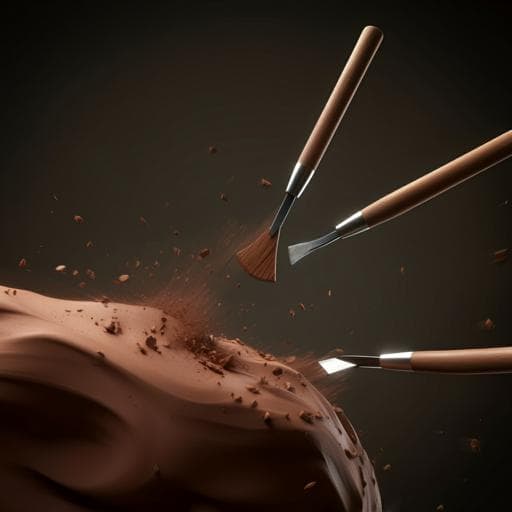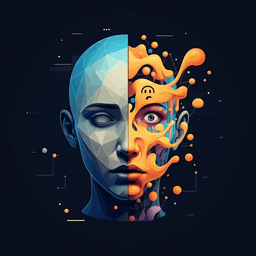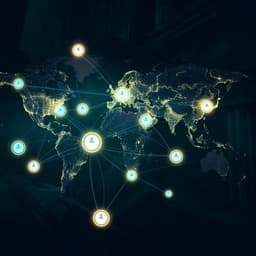
The Arts
Dynamics of artistic style: a computational analysis of the Maker’s motoric qualities in a clay-relief practice
N. Dick, A. Prusak, et al.
This exciting research by Nir Dick, Ayala Prusak, and Amit Raphael Zoran explores the dynamic interplay of artistic styles through motor techniques and their transitions. Discover how this innovative methodology allows for quantitative analysis of artistic creation, breaking free from traditional aesthetic evaluations.
~3 min • Beginner • English
Introduction
The paper addresses the research question of whether personal artistic style can be quantitatively defined and identified as a dynamic, time-dependent pattern of motor actions during making, rather than only as static visual attributes of finished artifacts. The authors argue that prior work has largely focused on analyzing pre-made products and their visual features, neglecting temporal motor activities due to technological constraints. Leveraging digital tracking and computational analysis, they propose defining dynamic style as transitions among a finite set of motor states (techniques) observable during an artist’s process. They present a quantitative framework that examines tool paths, extracts clusters of motor features, and analyzes relationships between these clusters across makers and tasks. The contributions are twofold: (1) a computational method to evaluate the dynamics of personal style; and (2) a proof-of-concept case study in clay-relief carving. The approach aims to enable studying making processes irrespective of final esthetics and to support future human-robot collaboration and computational creative tools by modeling an artist’s motor style.
Literature Review
The literature situates style across anthropology, art history, cognitive psychology, HCI, and AI. Davis (1990) frames style as a language of making manifest in artifact attributes, while Schapiro (1953) emphasizes constant elements in individuals or groups but notes observer dependence. Anthropological perspectives (Boas; Malinowski) link style to cultural signals and choices in material artifacts. Cognitive and behavioral studies highlight complex interactions in artistic creation, encompassing behavioral, cognitive, and motor aspects. With digital technologies, style can be connected to motor skills via tracking (wearables, smart tools) and computational vision methods that classify paintings or perform stylization (CNN-based analyses). Human-computer and human-robot interaction research suggests that effective collaboration requires modeling human intention as sequences of actions over states; a style-aware framework could enable robots to learn and predict a maker’s motor patterns and collaborate more intimately. The authors adopt a view of style as a manner of doing, focusing on motoric mechanisms and gestural causality. They distinguish between dynamic style (a finite, measurable set of temporally ordered motor acts) and static style (visual features in finished works). This background motivates a computational framework to analyze style as transitions among techniques over time.
Methodology
Case study and setup: The authors study clay-relief carving because it is accessible to novices yet requires skill, and supports both coarse and precise actions. A custom knife-like tool with an embedded motion-tracking sensor (Polhemus FASTRAK) records 6DOF tool pose at 60 Hz. The tool tip is modeled in epoxy by an experienced maker. Each session uses a standardized 20×20×4 cm terracotta clay slab prepared with a square mold and conditioned for 24 hours. Lighting and lab setup are held constant. Ethical approval was obtained; informed consent was collected. Datasets are available upon reasonable request to protect privacy.
Algorithmic framework: The tool trajectory is processed via digital signal processing and unsupervised learning. Each time sample is characterized by features capturing tool height (Z at the tip), orientation (Euler angles), and local high-frequency behavior.
- Height: Tool-tip Z coordinate; high-frequency components (via CWT) are used in analysis to capture rapid local variations linked to relief depth and idle modes.
- Euler angles: Capture manipulated plane orientation and tip usage. Due to angular wrap-around, two treatments are used: (a) embedding angles on the 2D unit circle for k-means, or (b) cyclic shifting to reduce discontinuities for GMM.
- High-frequency features: For a feature f, compute absolute CWT coefficients above s=0.5 Hz, then reduce dimensionality with PCA retaining 85% variance.
Feature-space normalization: Each feature is transformed into a distribution over its own clusters to form a normalized feature space. The number of clusters is estimated with Elbow and Silhouette methods; the authors fix three clusters for regular features and five for high-frequency features. Two strategies are used:
1) GMM-based: shift angles then fit GMMs to obtain posterior probabilities per cluster for each sample.
2) k-means-based: embed angles on the unit circle then compute probabilities proportional to inverse distances to cluster centers.
Principal tool states: The normalized feature space is clustered with k-means into k principal states (techniques), chosen to explain 90% of the variance. The process produces a time series of principal working states.
Comparative analysis: Working sessions are transformed into (a) distributions over principal states and (b) transition probabilities between states. Session-to-session distances are computed using Jensen–Shannon divergence over state distributions, transition distributions, or both. Distances are averaged over 10 repetitions and visualized via non-classical multidimensional scaling (MDS). Additional visualization includes 2D PCA histograms of the normalized feature space and session contributions.
Experiments:
- Novice study: Five participants (novices to clay relief, some craft experience) each perform three 30-minute tasks of increasing geometric complexity: (1) two-sided leaf-shaped ornament, (2) circular ornament with four equal sections, (3) purely circular ornament. Sessions are separated by 1–2 weeks. Each session includes a physical one-to-one model and a sketch on the clay surface.
- Expert study: One professional sculptor performs four long-term tasks: two 3D flowers translated to relief (3D→2.5D) and two flower-like geometric patterns (2D→2.5D). Over seven weekly meetings (2 hours each), the artist works 30 minutes on each task per meeting (total 3.5 hours per task), with task order varied across meetings. Distances between all sessions are computed as above, averaged over 10 runs, and embedded in 2D via MDS.
Key Findings
- Dynamic style detectability in novices: Even unskilled makers exhibit consistent motor patterns that can be identified via the proposed framework. 2D histograms of normalized feature space reveal personal morphologies; for example, Participant 5 shows a distinct set of tool states, while others are more similar, with occasional overlap (e.g., Participant 1 visiting Participant 5’s states). The distance-based embedding (MDS) clusters sessions by participant, indicating unique and consistent dynamic styles over 12 novice sessions (5 participants × 3 tasks).
- Expert differentiation by task category: In the expert’s 28 sessions (4 tasks across seven meetings), 2D embeddings based on both state and transition distributions show clear separation between flowers (3D→2.5D) and patterns (2D→2.5D), indicating that dynamic style depends on subject matter. Within-category dispersion is greater for organic flower tasks than for structured patterns, suggesting less consistent dynamics for flowers.
- Autonomous, unbiased detection: The correlations are derived solely from temporal motoric features and their transitions, without manual labels, linking low-level techniques to higher-level task categories. This implies that high-temporal-resolution motor tracking encodes cognitive information about the artist’s interaction with the model.
- Quantitative parameters: Data captured at 60 Hz 6DOF; features include height, Euler angles, and high-frequency CWT-derived components (threshold 0.5 Hz, PCA 85% variance). Feature clustering uses three clusters for regular and five for high-frequency features; principal states explain 90% of variance; distances use Jensen–Shannon divergence with non-classical MDS visualization.
Discussion
The findings support the hypothesis that personal artistic style can be represented as transitions among a finite set of motor states and identified computationally from tool-motion data. In novices, consistent and idiosyncratic dynamic styles emerge across tasks, confirming that even limited experience yields recognizable motor patterns. In the expert, distinct dynamic styles correlate with task categories (flowers vs. patterns), demonstrating that subject matter influences the selection and sequencing of techniques. These results address the research aim by showing that dynamic style can be quantified independently of final esthetics and can reveal higher-level cognitive and procedural differences. The approach has implications for human-robot interaction and smart tools: modeling the artist’s state transitions could enable robots to infer task structure, predict actions, and collaborate as style-aware partners or extensions of the artist. More broadly, the work provides a formal basis to study the language of making through motor features and their temporal interplay.
Conclusion
The study introduces and validates a computational framework for analyzing dynamic artistic style as time-dependent motoric functions, distinguishing it from static style derived from finished artifacts. Contributions include: (1) a method to extract principal motor states from 6DOF tool-tracking data using wavelet-based features, clustering, and transition analysis; and (2) a proof-of-concept application in clay-relief carving showing that novices exhibit unique, consistent dynamic styles and that an expert’s dynamic style varies with subject matter. The approach enables quantitative observation of making as an interplay of techniques, independent of final esthetics, and lays groundwork for personalized, style-aware computational tools and human-robot collaboration.
Future research directions highlighted by the authors include: analyzing style across multiple timescales; investigating the evolving relationships among style, technique, and skill; exploring links between makers’ mental imagery and their motor patterns; and studying interactions between cultural and personal esthetics. Computationally oriented questions include tracking how technique and skill change over time, identifying essential technical features for personal style characterization, and examining how iconography influences motor actions during making.
Limitations
The authors note that the complexity of style cannot be fully bounded within a controlled motoric investigation. The case study focuses on a single medium (clay relief) with a small sample (five novices and one expert), limiting generalizability; further work is required to extend conclusions to other media, tools, and larger, more diverse cohorts. Data privacy constraints limit public data release. Although the framework is robust, choices such as cluster numbers and feature selections are heuristic and task-dependent, and subject-matter effects observed in the expert study suggest that dynamic style may vary with content and context.
Related Publications
Explore these studies to deepen your understanding of the subject.







